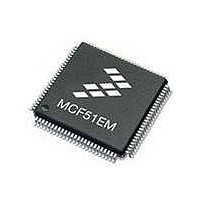MCF51EM256CLL Freescale Semiconductor, MCF51EM256CLL Datasheet - Page 486

MCF51EM256CLL
Manufacturer Part Number
MCF51EM256CLL
Description
IC MCU 32BIT 256KB FLASH 100LQFP
Manufacturer
Freescale Semiconductor
Series
MCF51EMr
Datasheets
1.MCF51EM128CLL.pdf
(2 pages)
2.MCF51EM128CLL.pdf
(54 pages)
3.MCF51EM128CLL.pdf
(636 pages)
Specifications of MCF51EM256CLL
Core Processor
Coldfire V1
Core Size
32-Bit
Speed
50MHz
Connectivity
I²C, SCI, SPI
Peripherals
LCD, LVD, PWM, WDT
Number Of I /o
63
Program Memory Size
256KB (256K x 8)
Program Memory Type
FLASH
Ram Size
16K x 8
Voltage - Supply (vcc/vdd)
1.8 V ~ 3.6 V
Data Converters
A/D 16x12b
Oscillator Type
External
Operating Temperature
-40°C ~ 85°C
Package / Case
100-LQFP
Processor Series
MCF51EM
Core
ColdFire V1
Data Bus Width
32 bit
Data Ram Size
16 KB
Interface Type
RS-232, LIN
Maximum Clock Frequency
50 MHz
Number Of Timers
3
Operating Supply Voltage
1.8 V to 3.6 V
Maximum Operating Temperature
+ 85 C
Mounting Style
SMD/SMT
3rd Party Development Tools
JLINK-CF-BDM26, EWCF
Development Tools By Supplier
DEMOEM
Minimum Operating Temperature
- 40 C
Lead Free Status / RoHS Status
Lead free / RoHS Compliant
Eeprom Size
-
Lead Free Status / Rohs Status
Lead free / RoHS Compliant
Available stocks
Company
Part Number
Manufacturer
Quantity
Price
Company:
Part Number:
MCF51EM256CLL
Manufacturer:
FREESCALE
Quantity:
110
Company:
Part Number:
MCF51EM256CLL
Manufacturer:
Freescale Semiconductor
Quantity:
10 000
- Current page: 486 of 636
- Download datasheet (11Mb)
Analog-to-Digital Converter (S08ADC16)
21.5.5.5
The total conversion time depends upon: the sample time (as determined by ADLSMP and ADLSTS bits),
the MCU bus frequency, the conversion mode (as determined by MODE and DIFFn bits), the high speed
configuration (ADHSC bit), and the frequency of the conversion clock (
The ADHSC bit is used to configure a higher clock input frequency. This will allow faster overall
conversion times. In order to meet internal A/D converter timing requirements the ADHSC bit adds
additional ADCK cycles. Conversions with ADHSC = 1 take four more ADCK cycles. ADHSC should be
used when the ADCLK exceeds the limit for ADHSC = 0.
After the module becomes active, sampling of the input begins. ADLSMP and ADLSTS select between
sample times based on the conversion mode that is selected. When sampling is complete, the converter is
isolated from the input channel and a successive approximation algorithm is performed to determine the
digital value of the analog signal. The result of the conversion is transferred to ADCRHn and ADCRLn
upon completion of the conversion algorithm.
If the bus frequency is less than the f
cannot be guaranteed when short sample is enabled (ADLSMP=0). The maximum total conversion time
is determined by the clock source chosen and the divide ratio selected. The clock source is selectable by
the ADICLK bits, and the divide ratio is specified by the ADIV bits. The maximum total conversion time
for all configurations is summarized in the equation below. Refer to
the variables referenced in the equation.
21-30
ConversionTime
Sample Time and Total Conversion Time
MCF51EM256 Series ColdFire Integrated Microcontroller Reference Manual, Rev. 8
Table 21-17. Single or First Continuous Time Adder (SFCAdder)
1
1
1
1
0
0
0
ADACKEN must be 1 for at least 5us prior to the conversion is initiated
to achieve this time
=
x
1
0
x
1
0
SFCAdder
0x, 10
0x, 10
Conversion Time Equation
11
11
11
11
ADCK
+
frequency, precise sample time for continuous conversions
AverageNum
Single or First Continuous Time Adder
5μs + 3 ADCK cycles + 5 bus clock cycles
5μs + 5 ADCK cycles + 5 bus clock cycles
3 ADCK cycles + 5 bus clock cycles
5 ADCK cycles + 5 bus clock cycles
3 ADCK cycles + 5 bus clock cycles
5 ADCK cycles + 5 bus clock cycles
(SFCAdder)
×
(
BCT
+
Table 21-17
LSTAdder
f
ADCK
).
1
1
through
+
HSCAdder
Freescale Semiconductor
Table 21-21
)
Eqn. 21-1
for
Related parts for MCF51EM256CLL
Image
Part Number
Description
Manufacturer
Datasheet
Request
R

Part Number:
Description:
BOARD DEMO HARDWARE ONLY
Manufacturer:
Freescale Semiconductor
Datasheet:

Part Number:
Description:
IC MCU 32BIT 128KB FLASH 100LQFP
Manufacturer:
Freescale Semiconductor
Datasheet:

Part Number:
Description:
IC MCU 32BIT 128KB FLASH 80LQFP
Manufacturer:
Freescale Semiconductor
Datasheet:

Part Number:
Description:
IC MCU 32BIT 256KB FLASH 80LQFP
Manufacturer:
Freescale Semiconductor
Datasheet:
Part Number:
Description:
Manufacturer:
Freescale Semiconductor, Inc
Datasheet:
Part Number:
Description:
Manufacturer:
Freescale Semiconductor, Inc
Datasheet:
Part Number:
Description:
Manufacturer:
Freescale Semiconductor, Inc
Datasheet:
Part Number:
Description:
Manufacturer:
Freescale Semiconductor, Inc
Datasheet:
Part Number:
Description:
Manufacturer:
Freescale Semiconductor, Inc
Datasheet:
Part Number:
Description:
Manufacturer:
Freescale Semiconductor, Inc
Datasheet:
Part Number:
Description:
Manufacturer:
Freescale Semiconductor, Inc
Datasheet:
Part Number:
Description:
Manufacturer:
Freescale Semiconductor, Inc
Datasheet:
Part Number:
Description:
Manufacturer:
Freescale Semiconductor, Inc
Datasheet:
Part Number:
Description:
Manufacturer:
Freescale Semiconductor, Inc
Datasheet:











